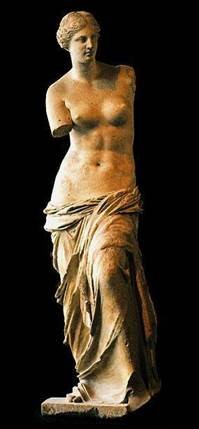 The Venus de Milo is a marble statue from Paros which probably represents the goddess Aphrodite. A masterpiece of the Hellenistic period, it is one of the most famous Greek sculptures. After two millennia of oblivion, the broken marble was unearthed in 1820 in the ruins of ancient Milos, a Greek island in the Aegean Sea. His discovery of the missing arms reinforces the enigma that surrounds this sculpture whose original pose has never been reconstructed, and whose author is still unknown... The incredible conditions of his discovery were almost fatal to him. Exhibited for the first time at the Louvre in 1821, her beauty as well as her missing limbs have consecrated her fame throughout the world.
The Venus de Milo is a marble statue from Paros which probably represents the goddess Aphrodite. A masterpiece of the Hellenistic period, it is one of the most famous Greek sculptures. After two millennia of oblivion, the broken marble was unearthed in 1820 in the ruins of ancient Milos, a Greek island in the Aegean Sea. His discovery of the missing arms reinforces the enigma that surrounds this sculpture whose original pose has never been reconstructed, and whose author is still unknown... The incredible conditions of his discovery were almost fatal to him. Exhibited for the first time at the Louvre in 1821, her beauty as well as her missing limbs have consecrated her fame throughout the world.
The discovery of the Venus de Milo
The Venus de Milo was discovered in the spring of 1820 in the Cyclades archipelago in Greece, in Melos or Milo. A peasant trying to build a wall around his field, digs the foundations and comes across a sort of crypt. At the bottom of this cave, he discovers a statue larger than life. A woman's face, with a bare chest, the right hand holding a garment reaching down to the feet, the left arm raised and folded.
 The peasant and his son carry the pieces of marble blocks to hide them at home. French sailors stopping on the island heard about this discovery, found the peasant and his son, admired the pieces of the statue and then quickly returned to Constantinople to warn the French ambassador, the Marquis de la Rivière. The secretary of the marquis, dispatched a month later on the spot, to buy this statue at any price, comes across Turkish sailors pulling the pieces of the Venus behind them! The fight begins...the bust is recovered...but the marble has suffered, debris is lying around. The French sailors take the whole thing on board, including the pieces, but do not realize that the arm is missing!
The peasant and his son carry the pieces of marble blocks to hide them at home. French sailors stopping on the island heard about this discovery, found the peasant and his son, admired the pieces of the statue and then quickly returned to Constantinople to warn the French ambassador, the Marquis de la Rivière. The secretary of the marquis, dispatched a month later on the spot, to buy this statue at any price, comes across Turkish sailors pulling the pieces of the Venus behind them! The fight begins...the bust is recovered...but the marble has suffered, debris is lying around. The French sailors take the whole thing on board, including the pieces, but do not realize that the arm is missing!
The goddess of love and beauty
The statue, back in France, was offered by the Marquis de la Rivière to King Louis XVIII, who had it exhibited at the Louvre in 1821. Questions abound concerning this missing arm…there are many hypotheses. We keep silent about the process of recovery of this statue, because it is useless to create a diplomatic incident... Jules Ferry, ambassador in Greece around 1872, tries to clear up the mystery and makes an expedition in the Cyclades. He finds the peasant's son who assures him that he saw the statue whole and intact and confirms that the French had removed the statue with force...and paid for it much later!
Representing Aphrodite, Greek goddess of Love, Venus for the Romans, she could also be Amphitrite, goddess of the sea venerated on the island where she was discovered. Dated from the year 120 BC, the statue is made up of two assembled blocks:the legs on the one hand, the torso and the head on the other. Holes in the arms prove that she was wearing jewelry:a bracelet and earrings, finally a headband in her hair.
Feminine and sensual to the end, with her legs draped to the hips, bare chest, no roundness, she appears to us supple and natural in her swaying hips. Was she leaning on a pillar? Was she holding back her clothes? Prosper Mérimée pays homage to the goddess of Love and Beauty, with such fine facial features, her hair carefully pulled back and tied in the Vénus d'Ille "such a woman, that I pity her lovers...and yet I don't 've never seen anything so beautiful".
The restoration of the Venus de Milo
It was in July 2010 that the Venus de Milo , more than two meters high, returns to a new place in the Louvre, after six months of restoration. Cleaned, because it had become brown….and because it had kept traces of plaster and oil, following the molding carried out in the 19th century, it is now installed and surrounded by objects discovered at the same time as it , in a huge room of two hundred square meters so that the six million visitors can admire it quietly.
Bibliography
- The Venus de Milo:A myth by Dimitri Salmon. Pocket, 2000.
- The Venus de Milo. 2010.
To go further
- The Venus de Milo on the Louvre Museum website.
